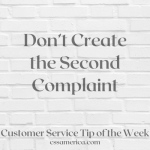A WOW Experience is not always one instance, one act that blows away the customer. It’s not always an over-the-top-the-employee-saved-the-day act of brilliance. Sometimes a WOW is the sum total of a series of little things that others don’t do – those actions that differentiate you from others. The customer may not visibly react, but – inside – they sense something different in a good way, something positive, something special.
When the customer walked in, you immediately looked up and informally greeted them. You smiled and even stood up!
They sent you an e-mail at lunchtime, and you responded mid-afternoon. The customer left a voice mail, and you responded in the next hour.
The patient had a question, so you turned away from the computer and patiently (no pun intended!) answered; you then asked what other questions they had in mind.
While they waited, you walked up to them and provided some educational information about the vehicle service you were performing for them as well as other useful features on their car – some they weren’t aware of previously.
The customer was talking to you – a customer service representative in some far away location – but you asked them for their name upfront and used it throughout the conversation.
A few days after the appointment, they received the handwritten thank you note that you penned on the day that you met.
Creating the WOW Experience doesn’t always require that over-the-top-the-employee-saved-the-day act of brilliance. You don’t have to be the best ever. But if you’re consistently better than what the customer experiences elsewhere, you become a WOW. You become the standard. You become that something positive, that something special in their day.
Use little acts to make a big impact.
Signup for FREE Tips! Contact Us More Resources for You Visit Our Home Page
























